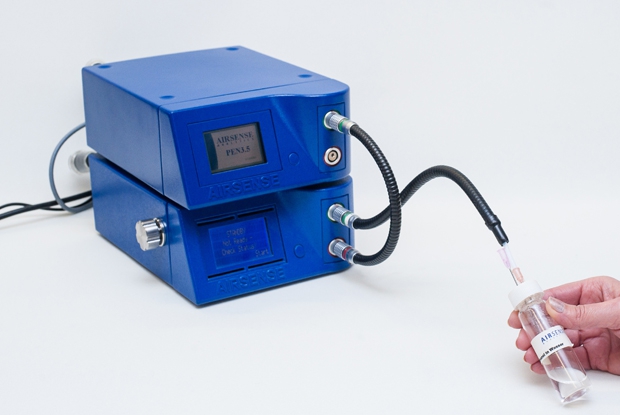Portable Electronic Nose PEN3
Intelligent Chemical Sensor for identification of gases and vapours.
The PEN, is a small, fast and robust identification system for gases and gas mixtures. The detection of the gases is performed with an array of gas sensors. Single compounds or mixtures of gases can be identified, after a training stage, by using the pattern generated from the sensors.
Using various algorithms, the instrument is able to identify up to 10 different compounds, or provides a straightforward answer like "Good-Bad", "Yes-No" depending on the needs of the user. The instrument can also deliver a quantitative statement.
Because of its particular sampling strategy the detector can be operated in the laboratory, or in mobile applications in the environment as well as online for process control applications.
For discrimination and identify compounds or mixtures of gases will require a first step of training equipment, in which the different profiles and algorithms that allow subsequent identification of the samples is created. With the creation of different algorithms the equipment will be able to identify up to 10 different compounds, providing the user easy answer like "Good - bad", "Yes - No". These responses can be adapted to the needs of users.
If the user requires, the equipment can also provide quantitative answers, based on previous calibrations of the same type of sample. There are developed a calibration procedure to ensure long-term stability. The equipment also includes a flow control specialized for stability.
Due to the equipment size and ease of sampling can be used in the laboratory as well as online for process control or environmental monitoring. The detector can be used with an additional head space or with EDU3 equipment allowing trapping compounds, previous analysis in PEN3 to pre-concentrate the samples.
This equipment can be connected directly to a PC, the device includes an easy and intuitive software control. The data can be analyzed with correlation systems, PCA, LDA, DFA, etc ... With this software the user has full access to all parameters of the instrument. The "WINMUSTER" software is compatible with Windows XP, Vista or Windows 7.
One of the main advantages of PEN3 system is the speed in analyzing the sample, allowing analysis of a sample in just 20 seconds, that with 40 seconds necessary to recover it, allows to obtain measurement cycles ≤ 60 seconds. The response of each of the sensors is less than 1 second.
Another major advantage of the equipment is that we can work at temperatures from 0 to 45 °C with humidity range of 5-95% which allows us greater autonomy and the possibility of working with the equipment outside the laboratory as an portable equipment.
Process Control:
• dosage of spices in food production
• supervision of industrial cleaning processes, fermentation processes
• dosage of artificial odour in natural gas
• production of polymer packaging material for food industry
• frying or roast process control
Advantages:
• Sensitive intelligent sensors
• Portable instrument with integrated display
• Small, fast, flexible and robust
• On-line sampling technique
• Integrated dilution control
• Works with computer or in standalone mode
• Data logger and off-line analysis
• Patented A3-Technology:
- automatic ranging
- automatic calibration
- automatic enrichment (opt.)
Quality Control:
Rancidity of oils, freshness of food, off odour in packaging materials, residual solvents in polymers, degradation of flavours, off odour in medicine, characterization of resins or aroma in beverages.
Environmental & Safety Control:
Odour in waste water purification plants or in compost plants (correlation with olfactometry), supervision of filters, solvents at workplace atmosphere, smouldering fires, identification of bacteria, leakage control or combustion emissions
|
Product Description |
|
|
Sensor technology |
hot sensors, working temperature 350°C … 500°C |
|
Sensor array |
10 different metal oxides single thick film sensors, optional adapted to application (*) |
|
Sensor response time |
typical: less than 1 second |
|
Inlet Sampler |
special fluidic connector |
|
Sample flow |
adjustable, 10ml/min to 400ml/min |
|
Flow system |
internal pumps, internal sample dilution system |
|
Measurement time |
depending on the application from 4 seconds to some minutes typical: 1 minute (20s measurements, 40s zero gas) |
|
Sensitivity |
LOD 0.1 to 5ppm for gases and organic solvents, e.g. 0.1ppm H2S |
|
Display |
graphical display |
|
Dimension |
255 x 190 x 92 mm |
|
Weight |
2.1 kg |
|
Environment Requirements |
|
|
Temperature |
typical: 0°C to 45°C |
|
Humidity (relative) |
5 % to 95 %, non-condensing |
|
Power Requirements |
|
|
Main power |
Power supply: 110 to 230VAC; max 30W or 12VDC (optional) |
|
Communications |
|
|
Computer interface |
USB port or serial RS-232 (optional) |
|
System Requirements |
|
|
Operating system |
Windows XP, Vista, Windows 7 |
|
Software |
WinMuster PEN for evaluation and analysis Algorithm for analyse: Euclid, Correlation, Mahalanobis, DFA, PCA, LDA and PLS |
|
Options |
Trap & Desorption Unit EDU Headspace-Autosampler |
|
Safety Class |
Compliant to EN292 Part1 & 2, EN294, EN61010-1, EN1050, EN60204-1, EN 55011 G1 CB, EN50270, EN61326 EN50270, EN61326 |
(*)
- W1C Sensor: Aromatic compounds
- W5S Sensor: Very sensitive, broad range of sensitivity, reacts to nitrogen oxides, very sensitive with negative signals
- W3C Sensor: Ammonia, used as sensor for aromatic compounds
- W6H Sensor: Mainly hydrogen
- W5C Sensor: Alkanes, aromatic compounds, less polar compounds
- W1S Sensor: Sensitive to methane. Broad range
- W1W Sensor: Reacts to sulphur compounds, H2S. Otherwise sensitive to many terpenes and sulphur-containing organic compounds
- W2S Sensor: Detects alcohol partially aromatic compounds, broad range
- W2W Sensor: Aromatic compounds, sulphur organic compounds
- W3S Sensor: Reacts to high concentrations (>100 mg/kg) of methane-aliphatic compounds
